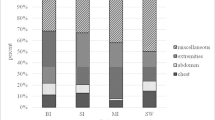Abstract
Background
Afghanistan has been plagued by war for more than 30 years, but little is known about the civilian cost of such a long-lasting conflict. In particular, the incidence of war injuries among civilians has largely been under-reported. EMERGENCY NGO’s Surgical Centre for War Victims has been operating in Kabul since 2001, providing care free of charge to anyone injured in war. The primary aim of our study is to describe the population of patients admitted to our hospital in Kabul.
Methods
This is a 5-year retrospective analysis of all recorded hospital admissions at EMERGENCY NGO’s hospital in Kabul, Afghanistan, from 1 January 2017 to 31 December 2021.
Results
During the study period, 16,053 patients were admitted. Of these, 85.7% were male and 17.5% were under 14 years old. The proportion of male patients increased progressively with the age ranges (from 63.4 to 89.0%). Bullet wounds were the most frequent kind of injury (55.6%), followed by shell, stab and mine wounds (32.2%, 8.3% and 3.9% respectively). Only 5.8% of patients arrived at our hospital within the “golden hour” following injury. No significant reduction in the hospitalization trend was observed over the study period. The overall in-hospital mortality rate was 4.41%, which bore no correlation to the number of admissions.
Conclusions
This study provides for the first time epidemiology of war-related injuries in a hospital located in a place of long-standing conflict.

Similar content being viewed by others
Data availability
Data will be made available upon request to the corresponding author.
References
Spagnolello O, Esmati S, Amiri AF, Shahir MAA, Gatti S, Portella G, Langer M. Kabul airport suicide bombing attack: mass casualty management at the EMERGENCY NGO hospital. J Trauma Acute Care Surg. 2022. https://doi.org/10.1097/TA.0000000000003724 (Epub ahead of print. PMID: 35687804.).
MacKenzie E, Rivara FP, Jurkovic GJ, et al. A national evaluation of the effect of trauma-center care on mortality. N Engl J Med. 2006;354:366–78. PMID: 16436768.
Aziz DA, Ibrahima T, Hode L. Les plaies crânio-encéphaliques: aspects épidemio-clinique set thérapeutiques à Dakar (Sénégal). Afr J Neurol Sci. 2011;30(1):38–46.
Paradot G, Aghakani N, Montpellier D, Parker F, Tadié M. Les plaies crâniocérébrales d’origine balistique: recherche d’arguments pronostiques. Neurochirurgie. 2008;54(2):79–83. PMID: 18339406.
Forrester JD, Auriel A, Cai L, et al. The golden hour after injury among civilians caught in conflict zones. Disaster Med Public Health Prep. 2019;13(5–6):1074–82. https://doi.org/10.1017/dmp.2019.42.
Valles P, Van den Bergh R, van den Boogaard W, et al. Emergency department care for trauma patients in settings of active conflict versus urban violence: all of the same caliber? Int Health. 2016;8:390–7. https://doi.org/10.1093/inthealth/ihw035.
Strada G. Una persona alla volta. Serie Bianca, Feltrinelli Ed; 2022. p35
United Nations Assistance Mission in Afghanistan (UNAMA). https://unama.unmissions.org/sites/default/files/unama_poc_midyear_report_2021_26_july.pdf
Spagnolello O, Gatti S, Esmati S, Shahir MAA, Portella G. Kabul airport suicide attack: report of a mass casualty. Eur J Trauma Emergency Surg. 2022. https://doi.org/10.1007/s00068-022-01898-y (Online ahead of print).
United Nations Office for the Coordination of Humanitarian Affairs (OCHA): Afghanistan. https://www.unocha.org/afghanistan
Acknowledgements
The authors would like to thank all the national and international staff who have taken part in the EMERGENCY NGO’s project in Afghanistan. A special thanks to George Cowie (EMERGENCY UK) for editing and language revision. In loving memory of Gino Strada (founder of EMERGENCY in 1994).
Funding
No financial support (funding, grants, sponsorship) is to be acknowledged.
Author information
Authors and Affiliations
Corresponding author
Ethics declarations
Conflict of interest
All the authors declare they have no competing interests.
Ethical statement
Not applicable.
Rights and permissions
Springer Nature or its licensor (e.g. a society or other partner) holds exclusive rights to this article under a publishing agreement with the author(s) or other rightsholder(s); author self-archiving of the accepted manuscript version of this article is solely governed by the terms of such publishing agreement and applicable law.
About this article
Cite this article
Spagnolello, O., Gatti, S., Shahir, M.A.A. et al. Civilian war victims in Afghanistan: five-year report from the Kabul EMERGENCY NGO hospital. Eur J Trauma Emerg Surg 49, 1401–1405 (2023). https://doi.org/10.1007/s00068-022-02137-0
Received:
Accepted:
Published:
Issue Date:
DOI: https://doi.org/10.1007/s00068-022-02137-0




